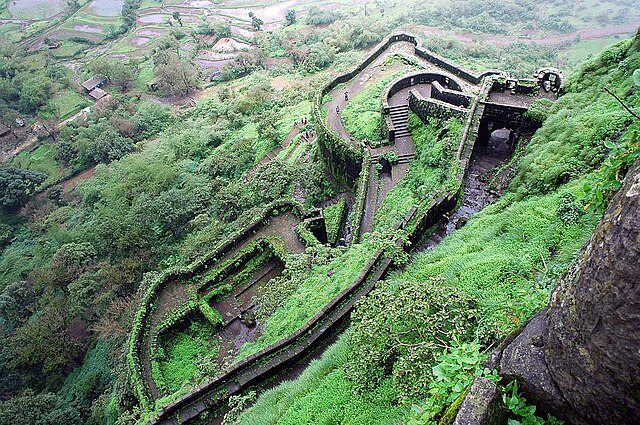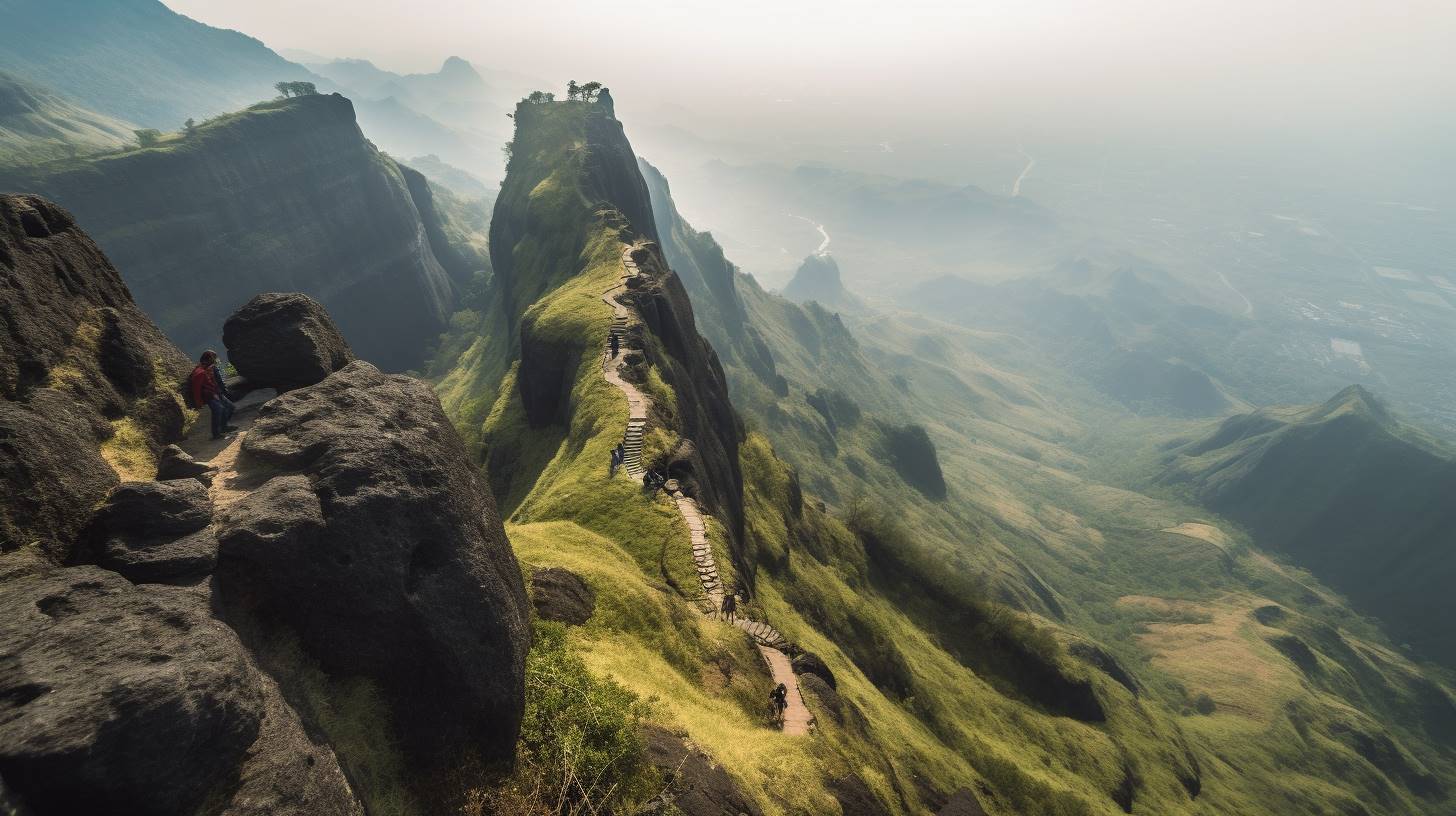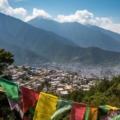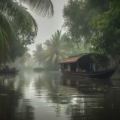Nestled in the lap of Maharashtra, India, Harihar Fort stands tall as an emblem of historical richness and natural beauty. This ancient fort, perched atop a triangular rock, has beckoned adventurers and history enthusiasts alike with its allure. Let’s embark on a journey to unravel the mysteries and treasures hidden within this trekker’s paradise.
Historical Significance

Dating back to the Yadava dynasty, Harihar Fort served as a watchtower to safeguard the ancient trade routes. Its strategic location facilitated surveillance over the surrounding landscape, making it a pivotal stronghold.
Geographical Location
Situated amidst the Sahyadri range, the fort boasts breathtaking panoramic views, with the River Nirgudpada gushing at its foothills. Its unique triangular shape and elevation of about 3676 feet above sea level add to its allure.
Challenges and Thrills of Trekking
Trek Difficulty
The ascent to Harihar Fort isn’t for the faint-hearted. The steep rock-cut steps, often narrow and precarious, pose a thrilling challenge to trekkers, demanding agility and determination.
Unique Features of the Trek
The journey isn’t merely about conquering heights but also experiencing the thrill of conquering fears, offering an adrenaline rush as trekkers navigate the ‘needle hole’ or ‘eye of the needle,’ a vertical rock patch.
Architectural Marvels of Harihar Fort
Fort Structure and Design
The engineering brilliance of Harihar Fort leaves one in awe. The fortification, although in ruins, showcases intricate architecture and ingenious water storage systems, reflecting the expertise of its builders from yesteryears.
Engineering Brilliance
The unique stepped well, the stepped entrance, and the distinctive rock-cut stairs stand as testaments to the architectural finesse prevalent during the fort’s construction.
Cultural and Historical Insights
Stories and Legends Associated with the Fort
Legend has it that the fort was named after Lord Hari, an incarnation of Lord Vishnu. Tales of valor and bravery echo through the corridors of history, evoking a sense of nostalgia and admiration among visitors.
Impact on Local Culture
The fort’s rich heritage has woven itself into the fabric of local culture. Festivals and rituals often pay homage to the fort’s historical significance, keeping its stories alive through generations.
Natural Beauty Surrounding the Fort
Scenic Views from the Fort
Perched atop the rock pinnacle, Harihar Fort offers mesmerizing views of the surrounding landscape. The lush greenery, coupled with the panoramic vistas, creates a canvas of sheer natural beauty.
Flora and Fauna in the Vicinity
The biodiversity around the fort adds to its allure. Rare species of flora and fauna find refuge in this ecological niche, creating a haven for nature enthusiasts and wildlife aficionados.
Conclusion
In the heart of Maharashtra lies Harihar Fort, a treasure trove of history, adventure, and natural splendor. Its towering presence amidst the Sahyadri range not only offers a thrilling trekking experience but also unveils a tapestry woven with tales of valor, architectural marvels, and ecological richness.
The fort, standing as a testament to ancient engineering and architectural prowess, invites adventurers to conquer its steep paths and witness the panoramic views it offers. Its cultural significance, intertwined with local traditions, adds depth and allure to its historical legacy.
Nature enthusiasts find solace in the lush surroundings and diverse flora and fauna, while history buffs are drawn to the stories etched within its walls.
Harihar Fort, beyond being a trekker’s paradise, embodies a living testament to the confluence of nature, history, and human ingenuity.
FAQs
1. Where is Harihar Fort located?
Harihar Fort is situated in Maharashtra, India, near the town of Trimbak in the Nashik district.
2. How do I reach Harihar Fort?
The nearest major city is Nashik. From Nashik, you can reach the base village, Nirgudpada, by road. The trek to the fort starts from this village.
3. What’s the difficulty level of the trek?
The trek to Harihar Fort is considered moderately difficult. The climb involves steep ascents, especially the famous ’80-degree rock-cut stairs’ leading to the top.
4. Are there any specific seasons for trekking to Harihar Fort?
The best time to trek to Harihar Fort is during the winter and post-monsoon seasons, roughly between October to March. Avoid monsoons due to slippery paths.
5. How long does it take to complete the trek?
The trek typically takes around 3-4 hours to reach the summit, depending on your pace and the crowd on the trail.
6. Is camping allowed on Harihar Fort?
Yes, camping is allowed on the fort. Many trekkers opt for overnight stays, enjoying the spectacular sunrise and sunset views.
7. Are there any safety precautions to consider?
Wearing proper trekking gear, carrying enough water and snacks, and being cautious during the steep climb are essential safety measures. Trekking with a local guide is recommended, especially for first-timers.
8. Can beginners attempt the trek?
While the trek is moderately challenging, beginners with reasonable fitness levels can attempt it. However, caution and preparation are key.
9. What are the attractions at Harihar Fort?
The fort offers breathtaking panoramic views of the surrounding landscapes, including Trimbak and the Brahmagiri mountain range. Its unique rock-cut stairs and the temple at the summit are notable attractions.
10. Is there an entry fee for visiting Harihar Fort?
As of recent information, there’s no official entry fee for visiting Harihar Fort. However, check with local authorities or guides for any updates.
11. Can I trek to Harihar Fort solo or is it better to join a group?
Both solo and group treks are possible. However, for safety reasons and to enhance the experience, many prefer going with a group or at least with a partner.
12. Are there accommodation options near Harihar Fort?
Nearby towns like Trimbak or Nashik offer various accommodation options, including hotels, guesthouses, and homestays.
13. What should I carry for the trek?
Essential items include trekking shoes, water, snacks, a first aid kit, a headlamp or flashlight, appropriate clothing, sunscreen, and a camera.


